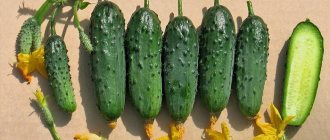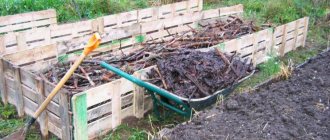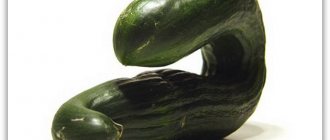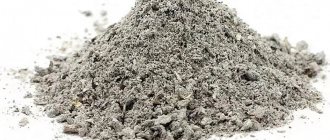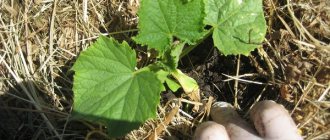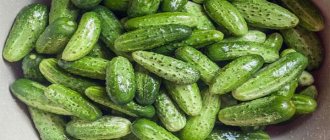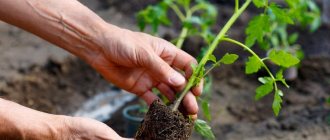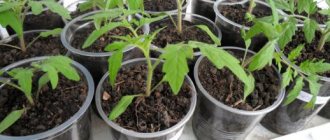» Vegetable growing » Cucumbers » Features of planting cucumbers under film
0
2226
Article rating
Planting cucumbers under film is one way to get a decent harvest. It allows you to grow vegetables in open ground even in regions with cold and short summers. Plantings protected by covering material are less susceptible to disease and do not suffer from pests or sudden temperature fluctuations.
- Technology
- Care
- Watering
- Feeding
- Hilling and weeding
- Disease Prevention
- Variety selection
Features of planting cucumbers under film
Description of growing cucumbers at home: when to plant?
For planting seedlings, the fundamentally important factors are:
- Soil temperature - must be at least 12*C (measurements are taken with a regular thermometer at a depth of 10 cm);
- The average daily air temperature should not fall below 15*C;
- No threat of return frosts;
- Rehabilitation - the length of the sun should be more than 12 hours (preferably 14-16 hours);
- Seedling maturity.
- Deadlines
In the video we plant cucumbers in open ground:
In the middle zone, the most acceptable time for planting seedlings in open ground is the last days of May - the first days of June. In the southern regions, where summer weather stabilizes earlier, planting can be done from the very beginning of May. In the north, planting in open ground is in most cases impossible due to the inconsistency of environmental conditions with the required conditions.
However, it should be remembered that there are no strictly defined disembarkation dates. Each time, landing must be planned individually, taking into account the entire range of influencing factors.
IMPORTANT: In addition to geographic location and climatic trends, when calculating the landing day, you should also rely on data from the Lunar calendar. In 2021, seedlings will show the best growth rates when planted between May 21 and 23 and May 26 and 28, as well as June 5 and 6.
Composition of soil for seedlings
There are several options for preparing soil for planting sprouted gherkin seeds.
- Sod soil, fresh sawdust and humus in a ratio of 1:1:2, urea 25g, wood ash 1 cup;
- Turf, humus, compost, ash;
- Peat, sawdust in a ratio of 8:2;
- Soil from the garden, peat, compost, sawdust in equal parts;
- Soil from the garden and humus (1:1).
Planting seeds
Cucumbers do not tolerate transplantation well. In order not to injure the plant during frequent replantings, it is better to plant the seeds in separate cups.
Pour the prepared soil mixture into the seedling container. We moisten with warm water and make shallow holes (1.5 - 2 cm). We plant the seeds, cover them with soil and water them again.
To make the seeds germinate faster, cover the cups with film. When the first sprouts appear, remove the film. We place the cups with seedlings on the windowsill, where there is more light. Water the cucumbers with warm water. After watering, the soil needs to be loosened so that the root system can develop better.
Preparing the beds
In order for cucumbers under the film to produce a large harvest, you need to choose the right site and prepare the ground. The most suitable soil for pumpkin crops is loam and sandy loam soil.
The most unfavorable conditions for cucumbers are acidic soil and dark areas. The area where pumpkin crops were previously grown is also not suitable. But a bed where cabbage or potatoes grew would be ideal.
First feeding of cucumbers: tips for choosing fertilizers and methods of their use. Step-by-step instructions for beginners
Self-pollinating varieties of cucumbers are the best varieties for greenhouses and open ground. Features of planting and growing self-pollinating cucumbers (90 photos)
Cold pickling of cucumbers: step-by-step description of the traditional cooking recipe, subtleties and tricks of canning cucumbers (125 photos + video instructions)
We dig up the bed, remove the top layer of soil 20 cm deep. We put straw, shavings, and manure there. We fill the top with earth. If there is not enough manure, then we simply dig it up. Manure is useful not only as necessary organic fertilizers, it also warms the soil well and improves its structure.
Features of growing under spunbond film
You can also try another method by creating warm beds for cucumbers yourself. To do this, prepare the future site for planting seeds or seedlings in advance. Dig up the area, the bottom layer is manure, which is biofuel for the bushes.
Its layer should be about a quarter of a meter. Sprinkle the organic ball with soil on top 15–20 centimeters. Usually the greenhouse is prepared in advance, in the first ten days of May.
After laying fertilizers, the soil must stand and warm up. When active growth and the appearance of inflorescences in cucumbers begins, carbon dioxide will begin to be released from the manure.
Instead of manure, you can also use dry grass or rotted compost. A layer of soil is removed, about 15–20 centimeters, and an organic layer is placed on top - thin twigs, hay, grass, leaves, sawdust. This layer is thoroughly compacted to create even greater heat release from the organic layer.
It is recommended to add at least a small amount of manure along with the grass. In combination with other components, manure will actively generate heat. And the grass and other components will retain this heat in the garden bed. This way the cucumber bush will grow and develop fully, without suffering from various types of rot and other diseases that often develop under the influence of cold and increased dampness.
Then pour over heated water, in which a small amount of potassium permanganate was previously mixed. The last layer is the soil that was previously removed from the beds. If the soil is of high quality and fertile, you don’t need to add anything else.
If the soil is poor in useful substances, you can additionally add mullein or compost. Next, cover the beds with film. After a week, you can start sowing the seeds. After planting the seeds, cover with film. If the weather is warm, open the greenhouse every morning and cover it again in the evening. Such procedures should be carried out until the second ten days of June, after which the covering material can be removed.
Landing in the ground
When the seedlings have 3-4 leaves, cucumbers can be planted under film. Approximately 2 hours before planting, water the seedlings. It is better to plant in the evening or on a cloudy day, otherwise the seedlings may burn or wither.
The optimal distance between plants is 40 cm, between rows 0.5 - 0.6 m. This is necessary so that the plants do not darken each other. We plant seedlings no lower than the cotyledon leaves. When planting, you need to be very careful not to damage the root system.
Post navigation
You probably won’t find a person who doesn’t love fresh, pimply, crispy cucumbers, especially those picked from their garden. This is a low-calorie fruit, mainly consisting of water, proteins, potassium, sugar, and vitamins. The fruit is well absorbed by the body and has a beneficial effect on the functioning of all organs.
Plants are widespread throughout all regions of our country; they are grown in all garden plots. However, the plant requires special attention and care. Typically, gardeners grow cucumbers under film cover: in greenhouses or greenhouses. There is an original way to grow cucumbers under film . Let's see what the point is.
growing cucumbers on film
Preparing the bed
The method of growing cucumbers on film does not require large investments of money and time. The main thing is to properly prepare the bed and, of course, follow the agrotechnical rules for growing cucumbers.
So, we are preparing the garden bed for planting.
- It must be remembered that the area for planting cucumber plants must be protected from the wind, level, with fertile soil. In addition, cucumbers should not be planted for several years in a row in the same area, or after pumpkins, zucchini, or squash, so as not to accumulate diseases and pests in the soil.
- Choose a bed 1.0-1.2 m wide and the required length. Be sure to cover the top of the bed with various organic residues in the form of undecomposed compost, manure, rotted straw, shavings, household waste, in short, everything that will successfully rot and give off heat. Lightly sprinkle all leftovers with soil.
- In the middle of the bed, prepare holes measuring 40*40*20 cm, distributing the soil evenly throughout the entire ridge, and fill the holes with a nutrient composition (compost, manure or mineral fertilizers, ash) below the main surface 4-6 cm, water and sow several seeds into the hole.
- Now you can cover the ridge with transparent plastic film without creating any frame. You can use old film, but without large holes, so that in the future weeds will not crawl out through the film. The film is securely pressed with boards or bricks so that the shelter is preserved until the end of the season.
- If cucumbers are planted as seedlings, then before planting, cross-shaped holes are cut out in the pre-fixed film.
cucumbers growing
Plant care
When seedlings emerge, the sprouts develop in a hole, like in a mini greenhouse, and are protected by a film from spring cold snaps.
When 4-5 leaves appear, the film over the plants is cut crosswise and the 3-4 strongest plants are left, not tearing them out, but plucking them out. And direct the remaining bushes in different directions.
Weeds in the cut are removed carefully so as not to damage the roots of the cucumber vines. The remaining weeds are left under the film, using them for the benefit of the cucumber bushes. As weeds grow, the film rises above the ground, forming a kind of soft cushion. Weeds with their breath additionally warm cucumber plants on cold nights. The soil under the film does not compact, does not dry out, and remains constantly moist.
The advantage of growing cucumbers under film is the absence of weeding, loosening, and reduced watering. The cucumber vines are on a film and do not come into contact with the ground, so the likelihood of diseases is significantly reduced, which reduces spending on various medications. And picking cucumbers is much more pleasant.
Watering plants
To water cucumber vines, use 1.5-3 liter plastic bottles from various drinks. To do this, cut off the bottom of the bottles, remove the cap and, having cut a hole in the film next to the hole, insert the bottle at a slight angle, making sure to secure it. You need to deepen the container so that the water does not quickly flow away and flood the hole, but also does not sit in the bottle, but slowly goes into the soil. Be sure to immediately check the installation of the bottles. Through bottles, plants can be fed with a solution of mullein or ammonium nitrate. Read how and how to fertilize cucumbers.
Growing cucumbers under film is suitable for almost any soil. The main thing is to properly prepare the bed and carry out all the agricultural techniques for this crop. Knowing how to grow cucumbers correctly, you will always have a good harvest.
If you find an error, please select a piece of text and press Ctrl+Enter.
Share with your friends on social networks!
I invite you to the group on Subscribe.ru for summer residents and gardeners: “Country Hobbies” All about country life: cottage, garden, vegetable garden, flowers, recreation, fishing, hunting, tourism, nature
Watering
Gherkins love moisture and warmth. Therefore, you need to water them more often so that the soil does not dry out and only with warm water. But you shouldn’t overwater the vegetable either - the plant’s roots may begin to rot.
Varieties of cucumbers for pickling and canning - 6 best and most popular varieties for canning (85 photos)
How to soak cucumber seeds before planting - 115 photos, features, tips and recommendations on how to properly soak seeds before planting
At what distance should cucumbers be planted in the ground and in greenhouses? Tips for choosing the optimal distance when planting and between beds (100 photos + video)
You can water only at the root of the cucumber, being careful not to water the leaves, so as not to cause burns on the leaves. Burnt parts of the plant are not restored.
How to care for cucumber crops
Since the roots of this crop are located close to the surface, they require constant loosening and constant irrigation. You can use a drip irrigation system. In order to retain moisture in the beds, it is recommended to lay mulch.
Watering is carried out at least three times during the week. It is better to carry out water procedures in the evening, when the heat subsides a little. If the weather is too hot, it is recommended to irrigate the soil under the roots without affecting the leaves. In extreme heat, it is recommended to shade young plants.
Fertilizer
Seedlings respond well to fertilization:
- organic matter (mullein, urea),
- mineral water (superphosphate, potassium phosphate, ROST 1, ROST 2).
Mullein is diluted with water in a ratio of 1:10. Consumption per plant is 1 liter. Urea is diluted during the first feeding in 10 liters of water with 50 g, and during the second - 10-15 g. Potassium sulfate and superphosphate are added to the soil at 20 and 100 g, respectively. Preparations ROST 1 and ROST 2 add 1 tablet each to a 10 liter bucket of water.
You can feed no more than once a month.
Agricultural technology
To get a good harvest, observe the temperature conditions of the soil and air and their humidity. On a sunny day, the temperature in the greenhouse should be from 25 to 30°C, on cloudy days 20 to 22°C. At night the temperature should not fall below 15°C. On hot days, be sure to ventilate the greenhouses without creating drafts.
Calcium nitrate for cucumbers: step-by-step instructions for using fertilizer for beginning gardeners (125 photos + video)
Bush cucumber - 125 photos, variety description, characteristics and video care instructions. Planting in open ground and in a greenhouse
Bread fertilizer for cucumbers and tomatoes - the best folk and modern remedies. Tips for choosing the composition and dosage (80 photos)
It is recommended to collect cucumbers at least once every 2 days, otherwise the yield will drop.
